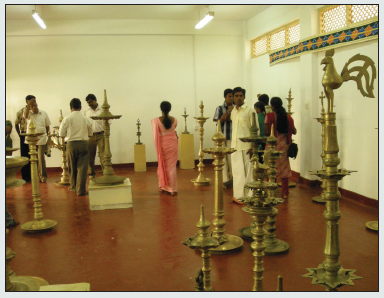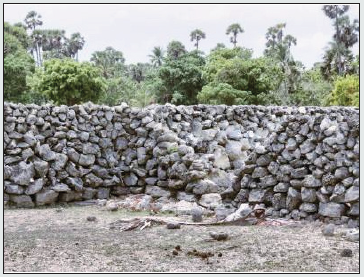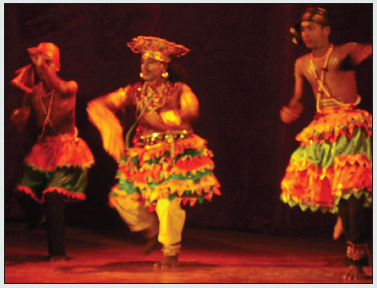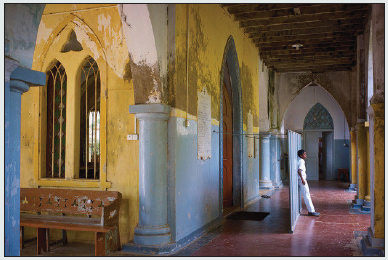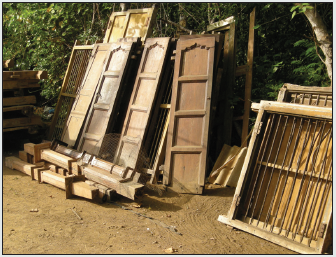
Lupine Publishers Group
Lupine Publishers
Menu
ISSN: 2690-5752
Short Communication(ISSN: 2690-5752) 
Heritage and Tamil Identity in the Context of Post War Sri Lanka Volume 5 - Issue 3
Cheran Rudhramoorthy*
- Associate Professor, Department of Sociology, Anthropology, and Criminology, University of Windsor, Canada
Received:September 17, 2021 Published: October 19, 2021
Corresponding author: Cheran Rudhramoorthy, Associate Professor, Department of Sociology, Anthropology, and Criminology, University of Windsor, Canada
DOI: 10.32474/JAAS.2021.05.000215
Abstract
I would like to begin with two recent developments in the culture and heritage front in Sri Lanka. In the first, the president of Sri Lanka, a former military officer and the former defence secretary, widely credited for defeating the Liberation Tigers of Tamil Eelam (LTTE), established two Presidential commissions. The first commission named the Presidential Task Force for Archaeological Heritage Management in the Eastern Province was established on June 2, 2020. A Buddhist monk Ellawala Medhananda Thero, who was described as “Archeological Chakravarthi” (Emperor of Archeology), in the official Gazette proclamation, was appointed as the chairperson of the task force [1]. The monk says that 99.9 % of archaeological and heritage sites in Sri Lanka are Buddhist . The second Presidential commission was established to amend the old colonial Antiquities Ordinance in order to “strengthen the preservation of antiquities and historical national heritage” [1]. Both commissions are comprised of members of the Buddhist Maha Sangha, Military Officers and a few academics. Both commissions were pan-Sinhala Buddhist commissions. There are no Tamil and Muslim representation in these commissions even though the first commission is exclusively for the Eastern province of the country where Tamils and Muslims form the majority. The department of Archaeology in Sri Lanka now functions under the Ministry of Defense. Thirty-five Institutions including some civilian bodies have come under the ministry of defence now [2]. Since the end of the war in Sri Lanka in May 2009, the government of Sri Lanka has been systematically implementing militarization and Buddhization in the North and Eastern provinces of Sri Lanka where Tamils and Muslims are in majority. After the end of the war, the government of Sri Lanka is engaged in a war of cultural and heritage to establish Sri Lanka as a country of and for Sinhalese and Buddhists alone. The warriors in this war are the Military, Buddhist monks, Department of Archeology and the ministry of Environment.
Introduction
What happens to heritage and identity in post war and post conflict societies when the Military become a major and sometimes sole agent of “Nation building” that inevitably includes reconstruction and development and in the case of Sri Lanka, preservation, articulation and conservation of national heritage? One of the most important developments in the post Iraq invasion by the United States and a group of coalition forces has been the emphasis and promotion of ‘nation-building’ also known as “Stabilization” and “Reconstruction” (SR) by the Military [3,4]. [5], in their study on development and military interface, note that the use of military force in the aftermath of a conflict is key to rapid and fundamental social transformation that can be achieved through social, political, cultural and economic reconstruction. The dominant official US discourse, notably since 9/11, has been couched in terms of national and international security, often mediated through the idea ‘promoting freedom’ and nation-building in ‘failed states.’ In these discourses the notions of Human Security and National Security operate not as counter points but as complimentary and necessary projects [6]. There are similar policies in the UK and European Union. A closer reading of these policy formulations and their implications tells us that these are state-centered and that most of these policy platforms paid no attention to cultural, heritage, Identity and human security; questions of communities and nationalities generally referred to as “minorities” that have either been excluded from State power or resisting State power (Figure 1).
Writing about the Canadian role in the reconstruction and development in Afghanistan, [7] says, “the primary objective of Canada should be to build and strengthen the Afghan state machinery and institutions for service delivery and lay the foundations of state stability”. The complex issues and demands of various communities in Afghanistan were neglected or erased for the benefit of the Afghan State. Similar developments have been going on in Sri Lanka. Since the war ended in 2009, hundreds of millions of dollars have poured into Sri Lanka but the local populations, mostly in the Tamil speaking regions left destitute by the conflict, have seen only slight improvements in their lives. Instead of giving way to a process of inclusive, accountable development, the military is increasing its economic role, controlling land and seemingly establishing itself as a permanent occupying presence. Combined with an effort to impose Sinhala and Buddhist culture across the whole of Sri Lanka and a failure to address many social aspects of rebuilding a society after conflict, the government explicitly proclaims and practices the Sinhala Buddhist nation and culture as supreme in the country, which impedes social healing in the country (Figure 2). As [8] correctly points out, the current cultural and heritage practices of the government of Sri Lanka clearly indicate the problematic conflation of history and heritage. While heritage can be a celebration of past and a claim making, history is a social scientific enquiry into the past. When both collide in the altar of majoritarian nationalism and exclusivist state practices, history retreats and morph into mytho- history.
Discussion
Now I want to draw your attention not only to tangible heritage but also to the intangible heritage of a community. This comes to us from the natural environment: The Great Barrier Reef is an important example of tangible heritage. There are sand dunes, there are shorelines, and there are various kinds of agricultural practices that are part and parcel of the community (Figure 3). They are all intangible heritage. Then we also have material culture: the artefacts, the handicrafts, and several other important artefacts that a community produces. These are also tangible heritage. What do we mean by intangible heritage? Our values. How the community has constructed their values over time. Oral history, art, music, literature and our culinary traditions, to cite a few. The other important aspect of intangible heritage is language. These are the general ways in which we approach the idea of heritage. And we are supposed to understand, explain, value, care for and endure our heritage. The notion of World Heritage has one important aspect: that kind of heritage does not simply belong to one community. That particular kind of heritage represents larger human civilisation; it belongs to humanity. There are particular kinds of heritage of a community that can be part of a larger human heritage. Hence, each community may have certain aspects of heritage that belong to the entirety of humanity. Technically speaking, UNESCO and the World Heritage Association have devised their own standards and their own criteria, and they then categorise heritage on this basis. That is why we have a list of World Heritage Sites around the world. There are three World Heritage Sites in Sri Lanka. And we need to remember these sites can be proposed only by the state, not by communities that do not have any state representation (Figure 4).
The traditional approach to heritage and culture is to assume that there are intrinsic and immutable values to culture and heritage. We expect that culture and heritage will not change and that it should not change. I would view this as a static model of heritage. This approach is not really helpful. For example, we cannot simply say that there is only one way to be a Tamil or to belong to Tamil heritage. In a similar way, we can also consider and articulate that certain aspects of heritage are sacred. That means we cannot tinker with it. At this point a question arises: do we want to preserve all kinds of heritage? For example, are we willing to preserve the heritage of sati (burning of wives in the funeral pyre of their husbands) or preventing the oppressed caste people from entering the temples? We cannot. In the name of heritage, we cannot simply preserve everything; that is a fountain for inequality and injustice. Rather than this simple way of defining and approaching heritage, I am proposing that we should develop a critical heritage strategy. In this critical heritage way, we consider heritage as a dynamic process – an interaction between the present and the past. We cannot create or understand heritage without an interaction between the present and the past. It is in that spirit that I would like to make the following observations, generally about culture and heritage, then Tamil heritage in particular (Figure 5).
Conclusion
Firstly, culture and heritage should be understood as attributes of a particular time, of a particular place, of a particular people. Secondly, all dimensions of heritage need to be constantly reevaluated and tested by social, cultural and political practices, needs and desires. These are the two parameters that I am proposing for a critical understanding of heritage. Hence, from this perspective, I would argue that it is necessary to view the attributes of heritage and articulate heritage as a medium and identity, and a worldview.
a) We should have a far-sighted planning on heritage, not treat it as a simple need for political and economic reasons.
b) It could be a platform for a political, civilisational and aesthetic recognition.
c) The heritage should be a medium for inter-cultural dialogue. It is not exclusive. For example, we cannot simply conceive and understand Tamil culture without understanding Malayalam culture or Kannada culture. Buddhism cannot be fully understood by linking it solely to Sinhalese. As Ayothee Thasar a proponent and savant of Buddhism and Dalit resistance in India says, “if you do not know Tamil, then you will not understand Buddhism fully”. There should be a cross-pollination and overlap. We cannot understand our culture without inter-dialogue. That is crucial. A lot of the difficulty with understanding heritage and culture is that we tend to be exclusivist. Nothing is pure. Everything is contaminated or rather cross-pollinated.
d) The heritage should also be a means of ethical reflection. Ethics in this context means responsibility and more importantly responsibility toward “Others”. We cannot talk about critical heritage studies without talking about our ethical, moral responsibilities.
e) Preservation and articulation of heritage could also be a means for progressive development. Ecosystems and the environment are an inseparable part of our heritage. Existing and dominant economic models do not consider the environment in their pursuit of unlimited profit and endless development. Ecological Economics should be our ethical way which could direct us towards critical heritage studies.
And finally, we also need to understand that heritage should be shared simultaneously by the local and the global, national and the transnational. We cannot simply confine heritage to its antiquity. It is impossible to confine Tamil heritage only to Jaffna and Batticaloa and Tamil Nadu. Tamil identities have now become transnational. More than a million Tamils live in various parts of the globe as refugees, former refugees and citizens and they constitute one of the large diasporas in the world. The culture and the values of the second and third -generation Tamils growing up in Canada and other parts of the world is part of Tamil culture and heritage whatever contestations one may have with these new articulations of Tamil identities. This culture and heritage are not confined to a particular territory. That is of key importance in understanding Tamil heritage [9].
What exactly do I mean by Tamil heritage by using this critical heritage perspective? I have identified eight aspects of Tamil culture and Tamil heritage that we need to be thinking and talking about and focusing on.
a) As we all know, Tamil is a classical language. There is a very beautiful, classical Tamil literature and this tradition is continuous, in the sense that we speak the language. It is from a long time ago-2,500 years, if note earlier - but we still speak Tamil. Not all the classical languages are available that way. There are only a few classical languages. In that sense, our contribution to human civilisation is perfectly there: this uninterrupted classical language, literature and poetry. It has not been appreciated enough but that is a second story.
b) We have had a secular tradition. The Tamil language has never been associated with any particular religion. We have Buddhism, we have Saivism, we have Islam, we have Christianity, we have Jains. We have a situation where you can identify every single classical language with a particular religion. English and Latin – Christianity; Arabic-Islam; and Sanskrit-Hinduism. You cannot identify Tamil with any particular religion. That is the most important secular tradition we have had for a very long time.
c) If we look at the cosmopolitan tradition reflected in classical Tamil poetry, we can clearly identify forms of diversity, and multiculturalism. I am not saying this in the spirit of, “before there was God there was Tamil” or “Tamils were the first people to invent helicopters and missiles”-I am not saying this with a hyper nationalist spirit. I am saying that with the evidence, that there has been a high degree of diversity, multiculturalism and secularism that have been articulated and practiced by Tamil Societies.
d) One of the very powerful traditions in Tamil is maritime seafaring, maritime trade and traveling. Understanding the historical, economic and cultural relationship of Tamils to Sea can be very useful in the discussion of Tamil identities. As Dereck Walcott would say in one of his most celebrated poems, sea is History, for Tamils too. For a very long time, even before the Tamils started leaving the country as refugees, they had a very strong tradition of seafaring. One of the key things about this maritime tradition is this notion of leaving the country. We are talking about diaspora now, but diaspora (pulampeyarvu)has a long history in the Tamil tradition in the pre-colonial, colonial and post-colonial eras.
e) It is in this context; the Muslims became part and parcel of Tamil heritage. Because in the maritime trade, some of the important trade guilds were Tamil Muslims. They were the people who would go to Southeast Asia and beyond. They were also the forerunners of modern banking. This is an important point I want to emphasize in these times of rising religious fundamentalism and exclusivist identities: without the inclusion of Tamil-speaking Muslims, Tamil heritage cannot be fully comprehended articulated. Tamil heritage and Tamil identities have largely been secular. Sticking a stamp of any religious identity on Tamil culture and heritage goes against the multicultural and multi-religious nature of Tamil identities.
f) The importance of Tamil labour and Coolitude. The labour during the initial maritime phases: we went elsewhere as traders. Then colonialism came; it came with dispossession. The colonialism made profit out of our dispossession. It is what you call ‘accumulation by dispossession.’ And because of colonialism, lots of Tamils from various parts became indentured labourers. We went to Malaysia. From Tamil Nadu they came to Sri Lanka. The labourer, the indentured labourer, has become a very important part of our heritage. Without the Malaysian Tamil indentured labourer, the automobile industry in the United States would not have succeeded. They are the ones who were largely responsible for rubber. Without rubber, Ford, and Chrysler, the largest automobile companies in the United States, would not have functioned.
In the beginning of the second world war, it was the Japanese who controlled 90% of the trade in rubber. During the second world war, the US found it hard to get the natural rubber it needed and invented synthetic rubber within two years, thereby limiting its dependence on rubber imports (Davis,2020). Tamil labour also played a significant role in the development of Singapore as a major city state. The labourer, the indentured labourer, the Coolie as an important is part of Tamil heritage and identity has never been articulated or studied. I think this is a crucial aspect that deserves attention. There are several communities that remember, memorialize and articulate slavery and indentured labour as important aspects of their heritage and identity, but the Tamils are not one of them. It is the “Coolitude” that Tamils need to focus on thinking about heritage and identity.
g) Finally, as I argued elsewhere [10], the Tamil heritage and identity are best explained and understood by the concept of Thinai - an eco-poetic classification of land, landscapes, feelings, music, flora and fauna. It is not just an identity based on language. “Race” and ethnicity - the terms that have modern origins-have not been used or abused prior to 18th century to identify Tamils [11- 13]. Based on the above eight aspects, we should be willing to reevaluate, rearticulate and reconceptualize our heritage and identity in the contemporary world of transnational linkages and multiple identities.
References
- (2020) Office of the President, Government of Sri Lanka. Task Force to Protect Archaeological Sites, Press Release.
- Sri Lanka Brief (2020).
- Dobbins James, John G McGinn, Keith Crane, Seth G Jones, Rollie Lal, et al (2003) America's Role in Nation-Building: From Germany to Iraq. Santa Monica, RAND Corporation, CA, USA.
- Ahilan Packiyanathan (2015) Kalathin Vizhimbu (Edge of the time) Jaffna, Pearu Publication.
- Stephan Klingebiel, Katja Roehde (2004) Development-Military Interfaces New Challenges in Crises and Post-conflict Situations. German Development Institute, Bonn.
- Bullimore Steven L (2006) The Military’s role in Nation-building: Peace and Stability Operations Redefined p. 1-22.
- Banerji Nipa (2010) Aid Development for a Secure Afghanistan.
- Wickramasinghe Nira (2013) Producing the Present: History as Heritage in Post-War Patriotic Sri Lanka. Economic and Political Weekly 48 (43): 91-100.
- Cheran R (2007) Theorizing Diaspori City. In History and Imagination: Tamil Culture in the Global Context. Cheran, R, Ambalavanar Darshan, Chelva Kanaganayagam (Eds.), Toronto, TSAR Publishers.
- Cheran R, Darshan Ambalavanar, Chelva Kanaganayakam (2008) (eds) New Demarcations: Essays in Tamil Studies. Toronto, Canadian Scholars’ Press, USA.
- Davis Wade (2020) The Unraveling of America.
- Higueras A (2013) Aid and Reconstruction of Heritage in the Context of Post-Conflict Societies. Archaeologies 9: 91-105.
- International Crisis Group (2012).

Top Editors
-

Mark E Smith
Bio chemistry
University of Texas Medical Branch, USA -

Lawrence A Presley
Department of Criminal Justice
Liberty University, USA -

Thomas W Miller
Department of Psychiatry
University of Kentucky, USA -

Gjumrakch Aliev
Department of Medicine
Gally International Biomedical Research & Consulting LLC, USA -

Christopher Bryant
Department of Urbanisation and Agricultural
Montreal university, USA -

Robert William Frare
Oral & Maxillofacial Pathology
New York University, USA -

Rudolph Modesto Navari
Gastroenterology and Hepatology
University of Alabama, UK -

Andrew Hague
Department of Medicine
Universities of Bradford, UK -

George Gregory Buttigieg
Maltese College of Obstetrics and Gynaecology, Europe -

Chen-Hsiung Yeh
Oncology
Circulogene Theranostics, England -
.png)
Emilio Bucio-Carrillo
Radiation Chemistry
National University of Mexico, USA -
.jpg)
Casey J Grenier
Analytical Chemistry
Wentworth Institute of Technology, USA -
Hany Atalah
Minimally Invasive Surgery
Mercer University school of Medicine, USA -

Abu-Hussein Muhamad
Pediatric Dentistry
University of Athens , Greece

The annual scholar awards from Lupine Publishers honor a selected number Read More...




